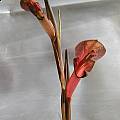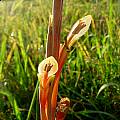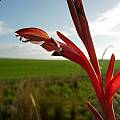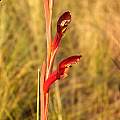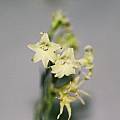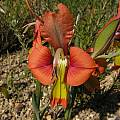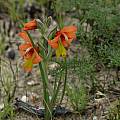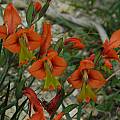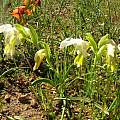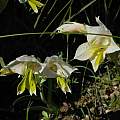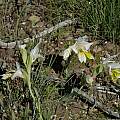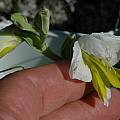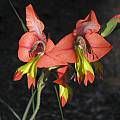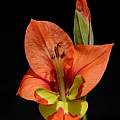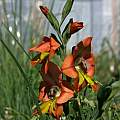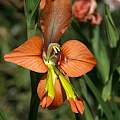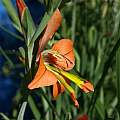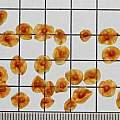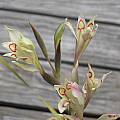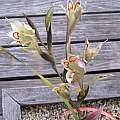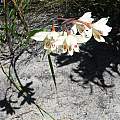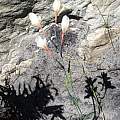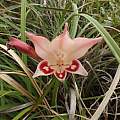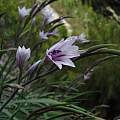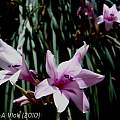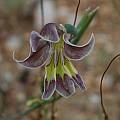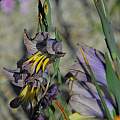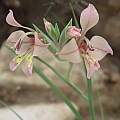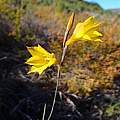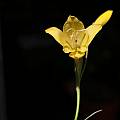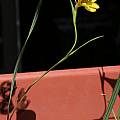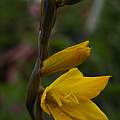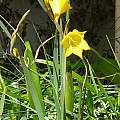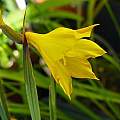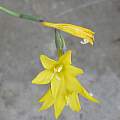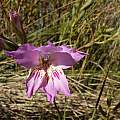Winter rain Gladiolus like their winters wet and mild and may need a dry summer dormancy. They are often less hardy, reaching down to USDA zone 8 at most.
Page 2: G. bonaspei... Page 3: G. carmineus... Page 4: G. debilis... Page 5: G. gracilis... Page 6: G. inflatus... Page 7: G. maculatus... Page 8: G. mutabilis... Page 9: G. pulcherrimus... Page 10: G. saccatus... Page 11: G. teretifolius...
Gladiolus abbreviatus Andrews (syn. Homoglossum abbreviatum) is an odd species with grossly unequal dark red to brown tepals. It is pollinated by sunbirds and occurs in the southwestern Cape where it is found in clay and shale banks in renosterveld. Although in the book above it is described as usually having 4 to 6 flowers my plants grown from seed only have a couple and ones seen in the wild also did not have very many flowers. The first photo was taken by Mary Sue Ittner of seed grown plants and the last three in habitat by Cameron McMaster near Napier in the Overberg.
Gladiolus acuminatus F.Bolus is an endangered species known from no more than five locations. It is endemic to the Overberg, where it grows in stony shale on flats and in renosterveld. It has a long perianth tube and pale greenish cream fragrant flowers. Photo by Alan Horstmann.
Gladiolus alatus L. is a winter rainfall species found on flats, slopes, and plateaus, mainly in sand. The flowers are orange, marked yellow and have a light and pleasant scent. Photo 1 was taken near Paarl September 2003 by Bob Rutemoeller. The next two pictures were taken by Bob Rutemoeller and Mary Sue Ittner near Bainskloof September 2006.
Photos below are a white form of this species. The first photo was taken by Alan Horstmann. The next two photos from Mary Sue Ittner and Bob Rutemoeller were taken near Villiersdorp. The last photo by Bob Rutemoeller shows a white form for sale in a nursery in Caledon.
The photos below are of plants in cultivation. Photo 1 by Mary Sue Ittner shows flowers on a plant grown from seed blooming March 2005. Photo 3 from Bob Werra. Photos 3-6 were taken by Nhu Nguyen. Photo 5 show seeds on a 1 cm square grid.
Gladiolus angustus L. is found in wet places on sandstone soils in the southwestern corner of the southern African winter-rainfall region. Growing from 60 to 120 cm high, it flowers in spring (October and November) with cream to pale yellow flowers with diamond spade shaped yellow markings outlined in dark red on the lower tepals. The species has a very long perianth tube, usually 7 to 10 cm, and the lower tepals are substantially shorter than the upper tepals. It is related to Gladiolus carneus and Gladiolus undulatus. The first two photos from Mary Sue Ittner. The next two photos from iNaturalist taken by Chris Vynbos and shared under a CC BY-SA license. The last photo from Rachel Saunders.
Gladiolus aquamontanus Goldblatt is a local endemic found on streams and wet cliffs in the Swartberg Mountains in the Western Cape. A winter rainfall plant, it grows from 40 to 100 cm, but mostly hangs down where it grows and has sword-shaped grey green evergreen leaves with lightly thickened margins and midribs. The mauve pink flowers are in a 4 to 8 flowered spike. The lower three tepals have a dark purple median streak in the lower two thirds. Flowers are unscented and bloom time is late spring to summer. One of the pbs list members who grows it has found that it never wants to be completely dry. The first photo from Rod Saunders. The next photo from the book Plants of the Klein Karoo courtesy of Jan and Anne Lise Schutte-Vlok.
Gladiolus arcuatus Klatt grows in the dry western part of the winter rainfall area of South Africa. In Namaqualand this species grows among low shrubs in granite derived gravel and in fine grained silt in areas to the south. It has flowers that are dull grey purple, brownish or dark purple, with the lower three tepals yellow in the lower two thirds with the distal third dark purple fading to light grey purple. The dorsal tepal is largest, horizontal and arching forward. Flowers are very fragrant and probably pollinated by long tongued bees. The first photo below could be this species. It was seen in early September 2006 in Namaqualand in the right habitat. The second photo taken earlier that year was taken at Rod and Rachel Saunders' property at Brackenfell. They often sprinkle seed about. I think it also could be this species. Photos 1-2 taken by Mary Sue Ittner. Photo #3 taken by Rod Saunders.
Gladiolus aureus Baker is endangered. It is found in the wild today in only a single location, a peaty seep on a rocky sandstone slope in the Southwest Cape. There are reportedly as few as ten plants remaining at this location. It has bright yellow flowers. The first photo was taken by Rachel Saunders August 2012 at its only known locality. There were five flowering plants surrounded by alien vegetation, houses and destruction. Photos 2-4 were taken by Bob Werra and the last photo by Michael Mace.
Additional information and photos from Ernie DeMarie: I grew three plants from seed that was refrigerated for well over a decade that came from the annual seed distribution of the Botanical Society of South Africa, which unfortunately they no longer do for international members. This species is not self compatible so when all three plants bloomed I was able to cross them and set a good amount of seeds. I distributed seeds or young corms to growers in California, South Africa, Australia, and Argentina in the hopes that this species could be maintained in cultivation as it is gravely endangered at its one locality on the Cape Peninsula.
Gladious aureus is not especially difficult to grow under my conditions but corms can exhaust themselves if they set a lot of seed. It will usually flower the third year from seed. It appears to reproduce mainly by seed; thus far I have not seen evidence of abundant cormlet production as happens with most other gladiolus species. It blooms in February for me. Being a small plant it can be managed under lights more easily than many other gladioli species.
Gladiolus blommesteinii L.Bolus is found on sandstone slopes in fynbos in the southwest Cape. It blooms August to October and grows from 30 to 60 cm high. Flowers are in a one to four flowered inclined spike, mauve or pink with dark longitudinal streaks on the lower tepals. Photo taken in habitat by Rachel Saunders.
Page 2: G. bonaspei... Page 3: G. carmineus... Page 4: G. debilis... Page 5: G. gracilis... Page 6: G. inflatus... Page 7: G. maculatus... Page 8: G. mutabilis... Page 9: G. pulcherrimus... Page 10: G. saccatus... Page 11: G. teretifolius...
